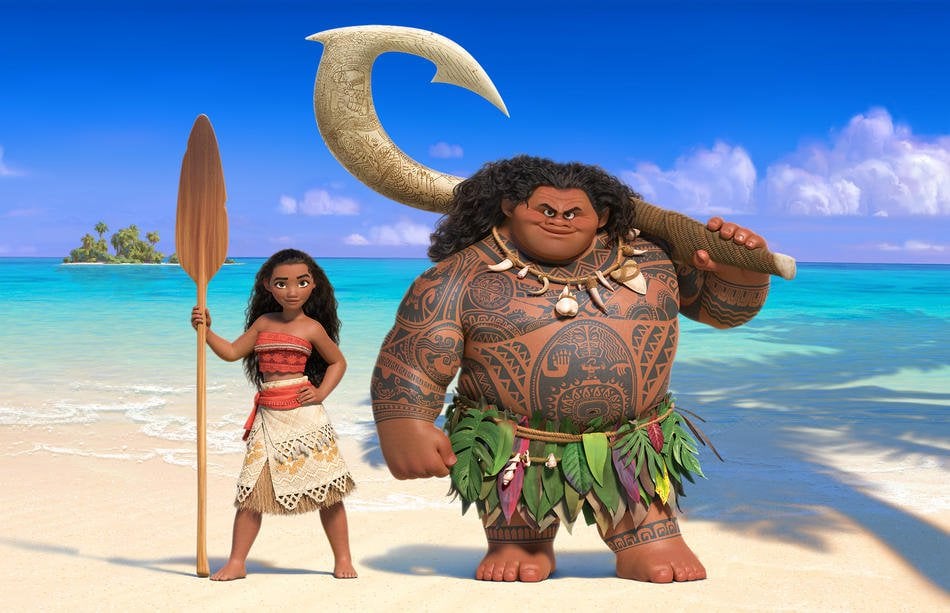“I’m not a princess. I’m the daughter of the chief!” exclaims the full-haired, cheeky Polynesian protagonist of “Moana,” who, despite her stereotype-breaking efforts, will surely appear in Disneyland’s Meet & Greet cue in no time. The beefy demigod Maui, played by ex-wrestler Dwayne “The Rock” Johnson, chides her with words that hit too close to home: “You’re in a dress and you’ve got an animal sidekick. You’re a princess.”
Disney’s latest oceanic venture, “Moana,” has it all: rapid age shifts, a merchandisable sidekick, tropical islands in the likeness of the Pixar short “Lava,” catchy compositions by Broadway superstar Lin-Manuel Miranda and perhaps the most dazzling visuals the studio has served up yet. Given all this, or maybe because of all this, it’s hard to cast off the feeling that the first half of “Moana” feels formulaic — a summer version of “Frozen,” if you will. It’s only when the movie strips away its forced quirkiness and Disneyesque optimism that it finally wins your heart.
The opening scenes of “Moana” feel like they were made to please. Feel-good vibes run through our protagonist’s village, encircled by a coral reef beyond which life-threatening high waves await. Like any daughter of a chief/king/ruling person, Moana’s destined to inherit the tribe and all the coconut trees of the island. But with the nudge of her bohemian grandmother who tells her — no great surprise — to listen to the voice inside her, she finds herself drawn to the edge of the water, eager to explore the whole wide sea. There’s only one complication: an overprotective father, somewhat of a recurring character in Diz films, who wants her to stick to the status quo.
Based off previous Disney installments and Moana’s catchy title song “How Far I’ll Go,” it’s obvious that Moana will leave the island eventually. Soon enough, her little utopia is poisoned by nameless causes: The land becomes sterile; all the fish disappear. If that wasn’t enough, a convenient death of a family member strikes out of nowhere. All these events happen very fast, existing only to push her out to the sea, where she must restore the heart of Te Fiti to bring back life to her island.
Like Moana herself, the movie wanders for a while in the sea of possibilities. A fleet of aggressive coconuts come and go, and a scene involving a kleptomaniac crab makes you think of Bilbo and Smaug. A particularly idiotic chicken, meant to be a sidekick and comic relief, may bring laughter the first few times, but will soon have audiences older than 5 years old rolling their eyes.
This is not to discount the fascinating visuals, of course, such as the anthropomorphized ocean, which is high-fiving Moana when it’s not parachuting her across great distances. Maui, whom Moana recruits to help her on her mission, lends his pecs and biceps for a creative tattoo scene, accompanied by a Michael Buble-sounding song, “You’re Welcome.”
But as with its best works, Disney finds a way to unexpectedly deepen what could be a very trite story. The second half of “Moana” manages to overcome its own tropes; it chooses instead to fully render Moana’s relationship with her grandmother, the legacy of her ancestors and Maui’s hurtful past — most of which are appropriately heart-wrenching and, in some parts, astonishingly beautiful.
And I do not say this lightly. “Moana” has real heart, not just a bionic one that sells tickets. Moana sings, struggles, sings again, makes mistakes, develops, blossoms and lays her claim to the deeply human traits that previous Disney princesses, waifish and constantly in distress, were denied. To top it off, she does it all during action scenes more exciting than anything from most recent blockbusters.
In a way, “Moana” is a movie coming into maturation itself. Only when it leaves behind the Disney formula and really tap into the inherent Disney-ness that has carried the studio so far, does it become the instant classic it is destined to be. Timeless stories about the wondrous, bewildering possibilities of life, stories that are capable of appealing to children but are never immature — these are what has been keeping the tide of audiences rolling into theatres for decades, not exhausting jokes, superficial characters and saccharine “cuteness.”
One last note: Stay in your seats for the post-credits scene. Like the movie itself, it takes a while, but it gets there.
Contact Elaine Kim at elainekm ‘at’ stanford.edu.
